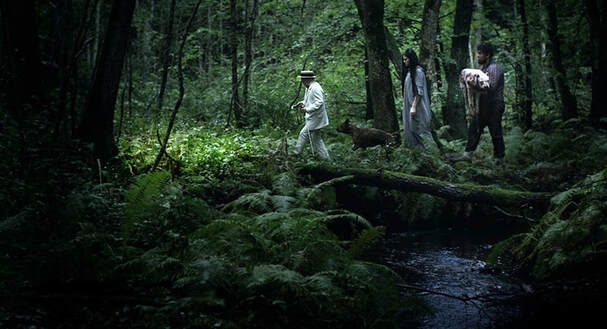 Imagine someone pitching this movie idea to you: A family goes on vacation for their daughter’s eighth birthday, but instead of happy times the celebration ends with the death of their only child. Now this is a very significant event, however, the main focus of the movie comes later when the couple goes on vacation in an attempt to salvage their marriage. While camping, the two grieving parents end up reliving this fatal trip over and over, and each time ends with torture and murder at the hands of three mysterious figures. If writer/director Johannes Nyholm pitched this film to me, I would first ask him if he was okay and if he needed a hug… …The Swedish film Koko-di Koko-da, which recently played at the Brooklyn Horror Film Festival, on the surface, holds qualities with Run, Lola, Run or Happy Death Day, but this movie presents with a far more depressing approach and comes to us wrapped in a much more artsy package. Nyholm creates a scary situation by forcing Elin (Ylva Gallon) and Tobias (Leif Edlund) to experience a never-ending home invasion (or camp invasion?), but the real emotion behind the film does not come from fear, but grief. Is there a term for a horror movie that makes you sad? Grief-horror? Fear-tears? Sad-ploitation? Whatever you call it, prepare to not be happy. In the beginning of the film, daughter Maja wanders from her parents and she becomes fixated on a music box decorated with an obscure forest scene. After the daughter dies, the forest scene begins playing over and over as if someone keeps winding up the music box. The three characters on the toy become the three mysterious attackers who hold no desire or motivation for anything besides torturing Elin and Tobias. Unable to move past the loss of their daughter, the mother and father’s physical pain manifests itself in the music box characters. Even when aware of what causes the pain and seeing possible escapes, the grief continues to bring harm upon the couple. Much like real grief, the characters know what they must do to heal, but they remain incapable of changing their pain. The continuous loop of death and torture will frustrate the viewer because no matter which method the couple uses to try to save themselves, the healing process remains unfulfilled. Nyholm incorporates a lot of childlike imagery and even music, which helps with the horror-side of the film. Throughout the genre, children’s songs hold an interesting place in horror movies. What should remind the viewer of innocence and youth, these songs instead present as eerie lullabies which usually serve as precursors for death. The simple child’s song from Argento’s Deep Red or the more sinister rope skipping chant of “One, two, Freddy’s coming for you” from the Nightmare on Elm Street franchise both present as simple kid songs, but would definitely bring a great level of unease to anyone if a children’s choir suddenly started singing them. Nyholm also incorporates the lyrics of a children’s song into his movie and even titles his film with the childish chant of “koko-di, koko-da”. While this phrase does not hold much meaning for English viewers, the words come from a well-known song in numerous European countries. The onomatopoeic phrase basically translates to “Cock-a-doodle-do,” which makes it seem the song would tell a story along the lines of “Old MacDonald”, but Nyholm does not pull from anything nearly as cheerful. Instead, the song tells of a dead rooster who can no longer sing “koko-di, koko-da.” Super cheerful for kids, right? Even more of a downer when the lead adversary in the film (Peter Belli) sings or whistles the song as he inflicts pain upon his victims. An incredibly eerie sequence occurs after the death of Maja and the director wordlessly shows the loss and heartache of the family through a shadow play complete with drawings mimicking those of a child. Nyholm expertly demonstrates sadness and emptiness even through crudely constructed puppets. The artistic choice of the director represents the idea that even a child can understand death, but actually recovering from grief remains far more complex of a process. Now, don’t let the artistic attributes of the film turn you away even if you are looking for a more traditional horror movie. While Nyholm sneaks in some more visually poetic moments, this nightmarish fairy tale-esque presentation of grief provides enough engaging material for most horror fans. By Amylou Ahava
0 Comments
Leave a Reply. |
Archives
March 2023
|


 RSS Feed
RSS Feed